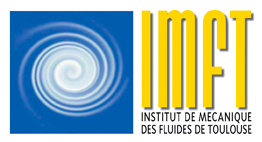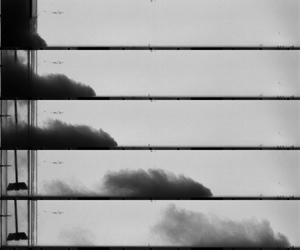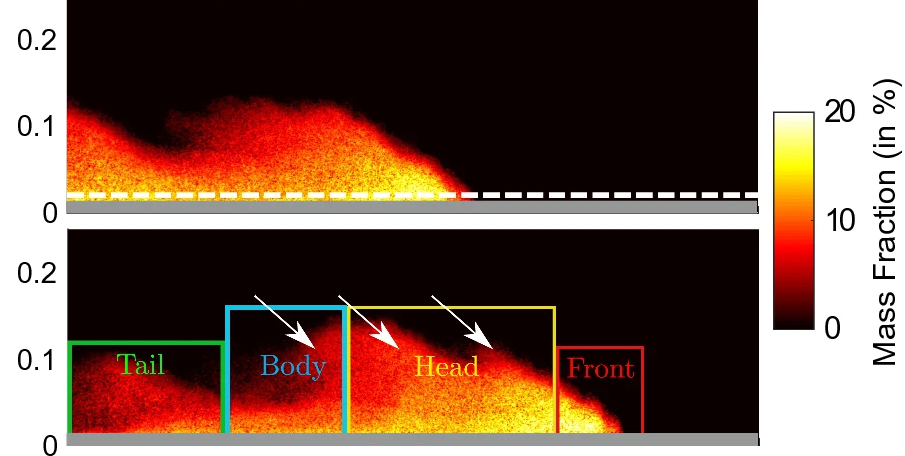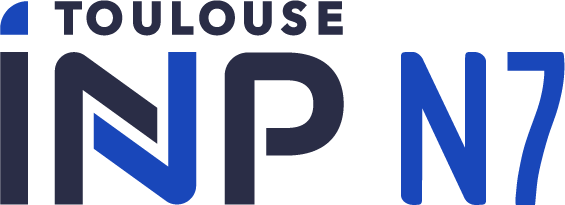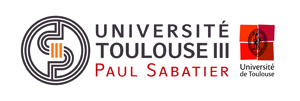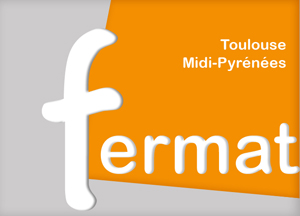PALAGRAM - PArticle-LAden GRAvity currents Modelling: From local physical processes to global dynamics
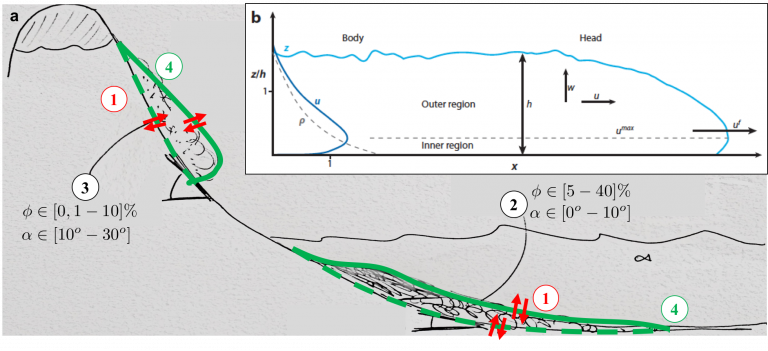
Partner Laboratories :
IMFT – INRAE – LEGI – LEMTA
Principal Investigators (PI) for each laboratory :
Lacaze L., Mercier M. (IMFT) – Naaim F. (INRAE) – Rastello M., Chauchat (LEGI) – Dossmann Y, Kiesgen de Richter S. (LEMTA)
PALAGRAM Objectives :
Gravity currents are buoyancy-driven-flows observed in a wide range of applications. In geophysical situations, gravity currents often involves dense particles suspensions as: pyroclastic flows, sandstorms, snow avalanches, turbidity currents or blowing snow in katabatic winds. Then, these gravity currents which includes or even are driven by particles will be referred to as Particle Laden Gravity Currents (PLGCs).
The goal of the PALAGRAM project is to investigate the connections between the local processes and the global dynamics of PLGCs, from the interaction of particles near the bed or in the suspension to the scale of topographic features like mountains, lakes or continental shelves. The main ambition is to provide models for the equivalent flow dynamics based on physical processes at the particle scale, including the slope influence.
A major difference between compositional currents and PLGCs is the existence of typical length and time scales associated with the particles dynamics leading to complex interactions between turbulence and particles denoted as turbulence-particle interactions. Among the relevant mechanisms, turbulence damping and preferential concentration play key roles.
During the project, we plan to i) characterize the effects of suspended-particles and mixing processes on PLGCs dynamics, including a characterization of apparent non-Newtonian effects and turbulence-particle interactions ii) develop new models for local processes such as bottom drag and particulate fluxes including turbulence and non-Newtonian effects; iii) provide a unified approach of PLGCs dynamics over a wide range of particle concentration and slope angle .
These scientific objectives will be addressed using a multi-scale experimental, numerical and theoretical approach. Complementary experiments will be led simultaneously in each laboratory. Using this approach, the project will address the following scientific questions:
- SQ1: How to measure accurately velocity and particle concentration profiles in PLGCs over the full range of concentration ?
- SQ2: What is the role of turbulence-particle interactions on erosion-deposition processes, dispersion of particles and mixing with the ambient fluid?
- SQ3: What is the influence of the PLGC rheology (non-Newtonian) on the PLGC dynamics?
Accordingly, the PALAGRAM project is divided in four tasks:
- Micro-scale description of steady and weakly-unsteady states : Erosion/deposition fluxes and local fluid-particle interaction (contact IMFT).
- Meso-scale description of unsteady state over weak slope : Dilute or dense PLGCs (contact LEMTA)
- Meso-scale description of unsteady state over steep slope : Dilute PLGCs (contact LEGI-INRAE)
- Closure models and parametrization for large scale modelling : Modelling of the overall dynamics (contact IMFT-INRAE-LEGI-LEMTA)
News regarding the project
2023/11/10 -- At LEMTA
Congratulations to Jean Schneider who successfully defended his PhD Thesis !
2021/03/24 -- In the media
Discover Florence Naaim, Hervé Bellot and their experimental facility (INRAE) in this documentary (in French) « Le monde de Jamy » on air 2021/03/24 dealing with the effects of global warming on our mountains (snow avalanches and debris flows): « Comment protéger nos montagnes? »
You can see the water tank where 3D experimental studies will take place by the end of the project, and one or two beautiful snow avalanches that are at the focus of PALAGRAM project (amongst other aspects), mainly in the first 30 minutes of the video.


Results presented in articles, at conferences or seminars
2023/10/23: Article in J. Fluid Mech.
Cyril Gadal, M. J. Mercier, M. Rastello, L. Lacaze. Slumping regime in lock-release turbidity currents. Journal of Fluid Mechanics, 974, A4 (2023). doi:10.1017/jfm.2023.762
2023/01/23: Article in Exp. Fluids
Schneider, J., Dossmann, Y., Farges, O. et al. Investigation of particle laden gravity currents using the light attenuation technique. Experiments in Fluids 64, 23 (2023). doi:10.1007/s00348-022-03562-y
